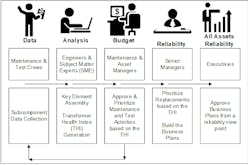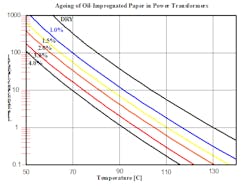With increasing pressure to lower costs, utilities are looking for tools to maximize the benefit of each dollar spent. Maintenance crews and engineers have a hands-on technical understanding but often lack a tool to communicate their story to the senior management and executives in an effective manner. Transformers are one of the costliest assets for utilities in their power generation and transmission portfolio. A large utility typically has in excess of a thousand power transformers ranging from 13kV to 765kV. Building a health index for transformers can communicate and justify upcoming needs, which will have a positive impact on operation and maintenance budgets.
Senior managers and executives need to be able to quickly access the three to 10-years potential expenditure for all major assets, including transformers. Without a systematic approach to communicate equipment issues, a weakness in reliability goes unnoticed until a major failure occurs. The Asset Health Index (AHI) is a way to place a wide variety of assets on the same scale so that reliability is monitored across all asset types. The AHI can be a tool to move expenditures from one budget cycle to another as resource dollars fluctuate.
The question becomes: How can utility companies more accurately assess funding for power transformers maintenance, testing, and replacement? AHI is becoming the largest indicator behind best practices for comparing assets and projects needs assessment for mid-term and long-term business plans. The same AHI principle can be used to develop a health index to rank transformers across the fleet.
Overview
Building a health index for transformers begins by choosing the correct key elements. The key elements must be obtainable, meaningful and routinely updated data for all transformers in order to ensure equitable scoring. A good transformer maintenance and test program should include all of the subcomponents needed to compose each key element. The subcomponents should include industry guidelines and numeric standards to make a proper interpretation. Once each subcomponent is evaluated, the scores are compiled to give a score for the associated key element. After each of the key elements are compiled, they are assembled into a total score referred to as the “Transformer Health Index” (THI). At this point each transformer in the fleet can be ranked by score and statistically analyzed.
Once each transformer is ranked, engineers and maintenance crews can focus their attention on the transformers with the lowest THI. This process allows cost and work scope to be developed, which is aimed at improving the low-scoring sub components, thus improving the THI. This methodology links the technical expertise with the first-level management, including maintenance and asset managers, to optimize the workflow and budget. Now the maintenance and program-level management team can present a more accurate and comparable forecast for the upcoming budget cycle for transformers. The iterative process of the THI development gives a clearer picture to the senior management and executives that drives confidence in the reliability. The THI also allows transformer needs to compete with other budget items and expenditures in the three to 10-year business plans.
The Four Key Elements
Utility maintenance programs generally consist of routine preventive maintenance (PMs) and predictive maintenance (PdMs). Based on these findings, corrective maintenance (CMs) activities are launched. All three types of maintenance activities are sources for the subcomponents from which the key elements are constructed. They are also consistent with the requirements of 1) obtainable 2) meaningful and 3) routinely collected on all transformers.
The key elements of a preventative maintenance program using the THI are 1) Dissolved Gas-in-oil Analysis (DGA) 2) Oil Quality Analysis 3) Age and 4) Electrical Test and Inspections.
Key Element 1 – DGA
Power transformers are filled with oil which serves to insulate and cool the transformer. The oil in a transformer is much like blood in the human body because the analysis can give great insight to the general condition and point out potential problems quickly without the need to perform an invasive procedure. Oil sampling is the least invasive form of testing for a power transformer since an oil sample can be taken while the transformer remains in service.
The oil consists of complex organic compounds composed of hydrogen and carbon atoms. Energy from electrical or thermal stress causes these complex molecules to break apart at various points. Also, if the electrical and/or thermal stress is in contact with the cellulose insulations system, it will cause the cellulose insulation system to break down as well. This process causes small amounts of gases to be formed. The particular gases and amounts vary according to the energy and temperature of the fault. The gases dissolved in the oil are low in volume compared to the oil. So, they are expressed in parts per million (ppm). These gases include: Fault gases — (hydrogen, methane, ethane, ethylene, acetylene, carbon monoxide, carbon dioxide) and Atmospheric gases – (nitrogen and oxygen).
The condition of the transformer can be tracked by routinely sampling the oil and analyzing the dissolved gas content. The routine oil-sampling interval varies from annual and quarterly to online sampling, depending on the criticality and loading of the transformer. Typically, transformers on the transmission grid are sampled annually even if they are deemed critical and equipped with an online oil-sampling monitor. Generating plant transformers are typically sampled quarterly since they run much closer to nameplate when in operation. Often critical Generator Step-up Unit transformers (GSUs) are equipped with an online oil-sampling monitor.
Key Element 2 – Oil Quality
Oil Quality test consist of several tests to quantify the chemical and physical properties of the insulating oil. The properties related to the oil breakdown because of moisture and oxygen ingress are of prime concern. These test results are routinely checked annually to access the condition of the oil. They are as follows: moisture in oil, dielectric breakdown, power factor, interfacial tension, neutralization number or total acid number, color and inhibitor content. Non-routine tests such as flash point, density and pour point are performed on newly purchased oil and the initial filling of the transformer because these properties tend not to vary as much over the life of the oil. Special test can be requested as needed, which include PCB, dissolved metals, corrosive sulfur, particle and furan.
Key Element 3 – Age
Age is actually a plot of the degradation curve of the insulation system, often referred to as the “bath tub curve”. The Original Equipment Manufacturer (OEM) often gives a generic life span of 40 years according to many older instruction books. But, depending on a company’s failure rate of power transformers, end of life because of aging varies from 15 to 100 years.
It is often said “The life of the transformer is the life of the insulations system”. The transformer’s insulation system consists of oil, solid cellulose insulation (pressboard/wood) and paper insulation. A failure of the oil because of signs of aging should never happen because the oil can be reconditioned, reclaimed or replaced. The deterioration of the solid cellulose insulation because of aging is normally not a problem as it mainly serves as mechanical support. The solid insulation system is like the human skeleton that holds items in place. Paper insulation is used to wrap the windings and leads. It is the most vulnerable component because of its large surface area which can be attacked by contamination. Once the paper is destroyed, it is almost impossible to replace unless it is on an unobstructed lead coming out of the winding.
Paper is made of tiny cellulose fibers from trees that have been spread into sheets, pressed and dried. A cellulose fiber is an organic compound consisting of a linear chain of several hundred to thousands of D-glucose units. This is referred to as Degree of Polymerization (DP). Paper in a new transformer consist of fibers lengths of approximately 1000 D-glucose units per chain or 1000 DP. Paper weakens as the cellulose fibers break apart into shorter chains. According to the Institute of Electrical and Electronics Engineers (IEEE), paper near the end of life has a DP of 200 or less. The cellulose chains or paper has three enemies that are always at work to break apart the long chains. These are oxygen, heat and moisture, which can be thought of as the Ohms Law for Transformer Insulation (OLTI). These three enemies work together to form acids and other aging accelerants in the oil.
Oxygen and moisture usually enter a transformer over a long period of time through various oil leaks or a poorly maintained oil preservation system. A path for the oil to escape is a path for air (oxygen and nitrogen) and moisture to enter. In the case of a nitrogen blanketed transformer, a nitrogen leak will allow oxygen and moisture to enter. On a transformer with a conservator tank, the conservator bladder and dehydrating breather must be well-maintained or else moisture and oxygen will enter. Heat acts to accelerate the aging process. Therefore, the cooling system must be properly maintained to obtain the maximum life of the transformer. If a transformer is undersized, which leads to frequent over loading, the transformer will not be able to achieve a typical 40-year lifespan. On the other hand, a transformer on the transmission grid that typically runs at 50% loading or less, can see a lifespan in excess of 80 years.
The age/degradation curve’s main goal is to set the upper bound of life expectancy for a category of transformers. As an example, transformers running at near rated output like a GSU will age much quicker than a transformer on the transmission grid that is only heavily loaded in the peak of summer or peak of winter. Therefore, transformers can be broken down into different categories based on application which relates to its temperature profile. Also, maintenance history and oil test can approximate the amount of accumulated moisture in the paper, which also affects the degradation curve. An IEEE paper written by EL Lundgaard, W Hansen, D Jinhjell, and JT Painter: “Ageing of Oil-Impregnated Paper in Power Transformers”, IEEE, 2004, shows a redrawn chart (Fig. 2) relating Life Expectancy in Years vs. Temperature in degrees C for various levels of moisture in the paper. See figure 2 below (redrawn for clarity).
Key Element 4 – Off-line Routine Electrical Test and On-line Inspection
During a substation outage, plant outage or a set number of months, a transformer gets deenergized. During this time frame, testing and maintenance activities are performed to check the condition of the transformer. More advanced programs require testing at the start of the outage so that any issues found can be corrected before the outage is over. In some cases, issues found may cause the outage to be extended. These tests include main winding power factor, bushing power factor, winding excitation, DC insulation resistance, winding resistance, turns ratio, core ground (if applicable), de-energized and/or load tap changer test (if applicable), bushing CT test, gauges and relays. These intervals range from 18 to 72 months. Generating plant transformers are more frequently tested than the transformers at substations on the transmission grid because of the higher load factor at plants and plant outages for other equipment.
On-line inspections come in many forms and depths of inspection. The inspections range from a daily walk around to an annual detail visual and infrared inspection that checks the alarm points and checks the cooling system functionality. The goal includes checking for low oil levels in the main tank, low oil levels in the bushings, high temperatures in the windings or top oil, oil leaks, trouble in the cooling system (pumps / fans), hot spots on bushing connections, and unusual sounds.
Summary
Part 1 has shown how electric-utility technical groups and management teams can more efficiently communicate, establishing a formal process for assessing and reporting transformer maintenance, through the development of the health index. This tool puts in place a common language that allows for communication between all levels from executives to maintenance crews. Part 2 and 3 in the series will explain the process for “Understanding and Collecting the Sub-components” and “Presenting the Transformer Index”.
Editor's note: Mark Goff, a retired engineering manager with the Tennessee Valley Authority (TVA), is on a mission to bridge the communication gap between electric-utility technical groups and management teams. It is one of the biggest problems he faced in his 34-year career at TVA. In Part 1 of this three-part series, Goff lays out an overview of his proposal to create a numerical health index and establishing a practical program for power transformer maintenance. The process is applicable to other major grid assets.
Mark Goff is a member of the T&D World Executive Insights board.
About the Author
Mark B. Goff
Mark B. Goff is a member of the T&D World Executive Insights Board and is responsible for multiple technical publications. His experience spans a 34-year career at the Tennessee Valley Authority (TVA) — from field test engineer to systems engineer to manager of the Electrical Energy Conversion group in Generation Engineering. He built an effective transformer, breaker, and infrared test program and maintenance support group. He is currently working as an engineering consultant.


